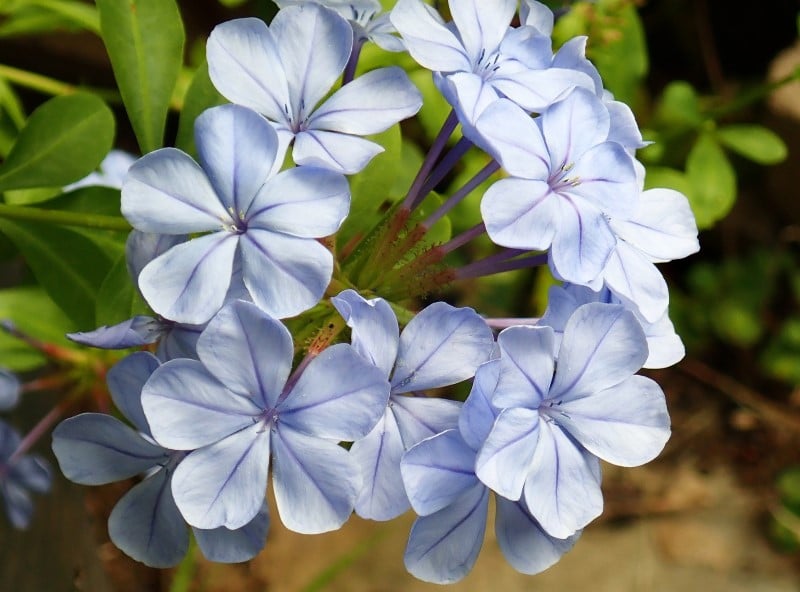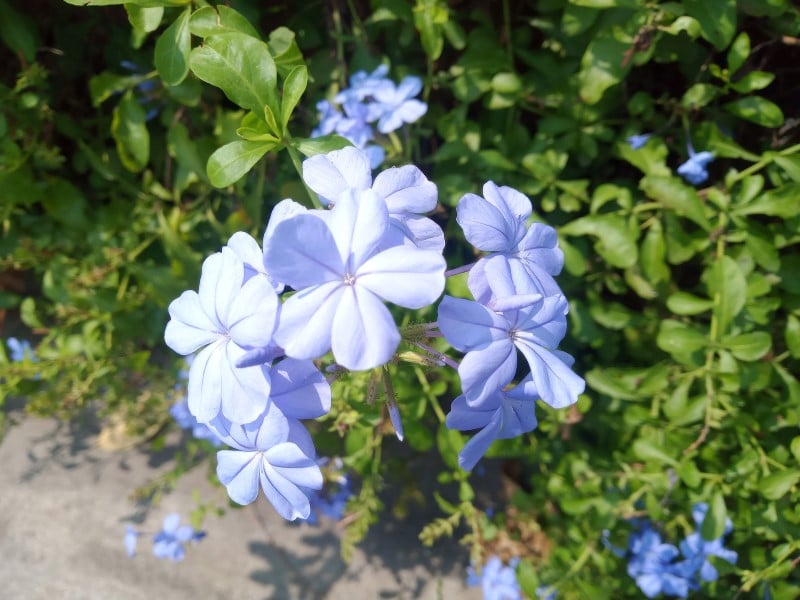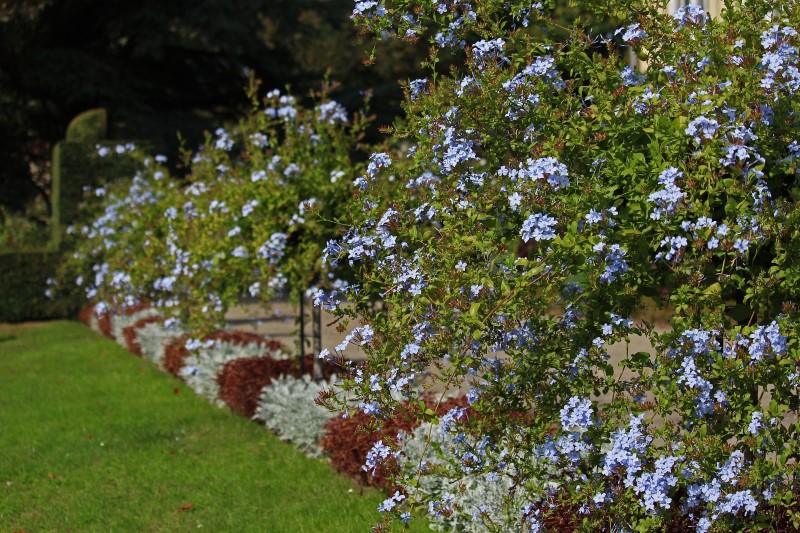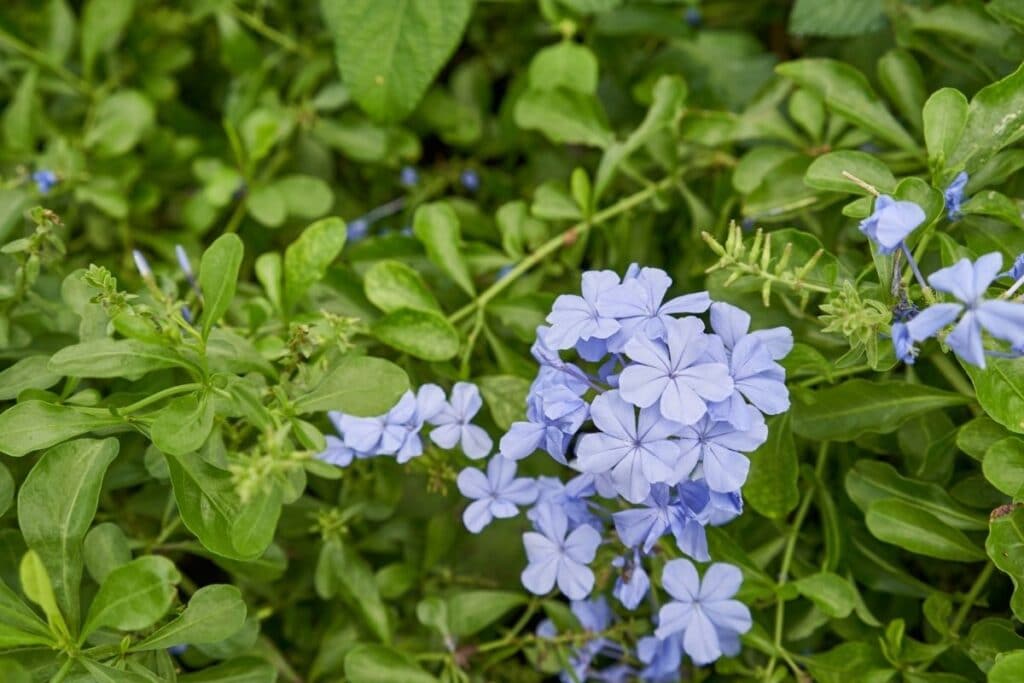Plumbago is a beautiful blue flowering evergreen for warm and subtropical areas. These low-maintenance plants are naturally pest-resistant, making them a great choice for beginner gardeners looking to add color to the landscape.
Read on to learn more about how to grow and care for this attractive and undemanding shrub.
What Is A Plumbago Shrub?
Plumbago auriculata, or just Plumbago, as it’s usually known, is an evergreen shrub with climbing tendencies from the Plumbaginaceae family. These plumbago plants are also called cape plumbago, blue plumbago, sky flower, leadwort, or cape leadwort. Along with P. auriculata, there are about 20 different plumbago species in the genus.

These very fast-growing shrubs are native to South Africa, and they usually grow to about 10 ft (3 m) tall and wide. The thinly textured leaves of this plant are bright green when young, darkening with age and can be anything from 1 to 3 inches (2.5 to 7.5 cm) long.
Plumbago Flowers
Plumbagos produce masses of beautiful sky blue flowers, or occasionally white flowers on new wood, each with 5 petals. These plumbago shrubs flower on new wood in spring, summer, and fall or at any time of the year in areas without frost.
The calyx of these flowers is covered in sticky hairs which are thought to help disperse the plumbago seeds when the unusual blue flowers stick to the coats of passing animals.
Some sources suggest that these plants may be carnivorous during flowering, although the sticky hairs may simply be a defense against insects.

Other Plumbago Species
P. zeylanica or the white leadwort or chitrak is a white flowering species that is found in tropical and subtropical areas throughout the world. This plant grows to about 5 ft (1.5 m) high, and a little wider. This species enjoys full sun and can be grown in zones 10 and 11.
P. indica, is another plumbago plant that is suitable for gardening. This plant is commonly known as the Indian or scarlet leadwort. These Southeast Asian plants produce beautiful pink flowers and grow well in subtropical climates.

How To Grow Plumbago Plants
The plumbago is a fast-growing plant that is quite easily grown from seed, sown in the spring. Growing from cuttings is another good option for propagating new plants, although probably the easiest method is to simply remove and replant suckers. (1)
These flowering plants are quite tolerant of a variety of soil types, although they show a preference for slightly acidic well drained soil that is fertile and contains organic material.
Plumbagos are adapted to grow in areas with a distinct rainy season. They have moderate water needs and can be quite drought-resistant once established.
Just be sure to water your plant regularly for the first few weeks after planting to help it through the stress of planting. Plants grown in a container will usually need to be watered more regularly than those planted in the ground.
Plumbago shrub does best in full sun but will tolerate partial shade, so plant this shrub in a bright and sunny spot if you have one available.
Choose a site that is protected from wind if possible and plant plumbago somewhere with enough room for it to spread to its full size. Plumbago does best if grown in USDA zones 8 to 11.

Care and Maintenance
Plumbagos are very low maintenance plants that are very tolerant of pruning, making them a great choice for a formal hedge.
Frequent pruning may either stimulate, or diminish flowering depending on the timing, but it is often necessary to keep this spreading plant looking neat and compact.
Growth can be quite vigorous and this plant will climb structures and other plants so keep the shears at hand. This plant grows by suckers and can spread quite widely if left to naturalize. Simply remove these suckers to keep your plant contained. Plants can be cut right back in winter, or you can remove frost-damaged growth in early spring.
Plumbago is a plant that prefers a mild climate and will drop leaves if exposed to frost. In very cold areas, this plant might grow as a perennial or may even have to be grown as an annual.
Generally, additional fertilizing is not necessary when growing these indoor plants but if you have very nutrient-deficient soil, and your plant is not blooming, you may wish to fertilize with an organic fertilizer in the warmer seasons.
These plants tend to be naturally pest and disease resistant but try to maintain good airflow between plants by spacing them adequately.
Uses
Horticultural Uses
Plumbago bush has many uses in the garden. These plants look great when grown in containers and allowed to hang over the edges of pots. Other common uses include growing as foundation plantings, ground cover, or even growing as a vine on arbors, on a trellis, or on fences.
Human Uses
The roots and leaves of this plant have been used traditionally in South Africa as a treatment for headaches, warts, and fractures. (2)
Wildlife Uses
Pollinators like butterflies enjoy visiting the blossoms of this plant. Fortunately, plumbago is considered to be a deer resistant shrub.
FAQs
Is plumbago indoor or outdoor?
Plumbago is primarily grown outdoors in gardens and landscapes, where it thrives in warm climates. It can be cultivated as a perennial in USDA hardiness zones 8-11.
Can plumbago be grown in pots?
Yes, plumbago can be grown in pots or containers, which is especially useful for gardeners in cooler climates who may need to bring the plant indoors during winter or frosty conditions. Ensure the container has adequate drainage holes and use a well-draining potting mix.
Can plumbago be a houseplant?
Yes, Plumbago can be grown indoors as a houseplant, but it requires bright, indirect light and consistent warmth to thrive. It may not flower as profusely indoors compared to outdoor growing conditions, but it can still make an attractive foliage plant.
Why is my plumbago dying?
Several factors could cause a plumbago plant to decline, including overwatering, underwatering, inadequate light, pests, diseases, or environmental stress. Assess the plant’s care routine and growing conditions to identify and address any issues promptly.
Is Plumbago toxic to humans?
Plumbago contains compounds that are toxic if ingested, and contact with the sap may cause skin irritation or allergic reactions in some individuals. Keep the plant out of reach of children and pets, and wash your hands thoroughly after handling.
Can you grow Plumbago from cuttings?
Yes, plumbago can be propagated from stem cuttings. Take 4-6 inch cuttings from healthy, non-flowering stems, remove the lower leaves, and plant them in moist, well-draining soil. Place the cuttings in a warm, bright location, and they should root within a few weeks.
Conclusion
As a beautiful, low-maintenance plant that can be used in a number of ways in the garden, plumbago is hard to beat. Provided you live in the right climate zones, consider this plant for the evergreen foliage and attractive blue floral accents it provides.
If you love blue flowering shrubs, check these plants with blue flowers.
References
Reference List:
(1) Aubrey, A. Plumbago auriculata.
(2) Van Wyk, B., van Oudtshoorn, B. & Gericke, N. Medicinal Plants Of South Africa.
Close
*image by eaglesky/depositphotos







